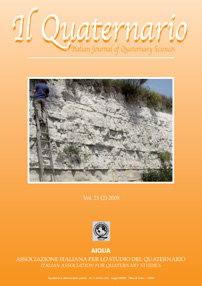Evoluzione quaternaria del bacino di Leonessa (Rieti)
Main Article Content
Abstract
Fubelli G., Falcucci E., Mei A. & Dramis F: Quaternary evolution of the Leonessa basin. (IT ISSN 0394-3356, 2008).
The Leonessa basin is one of the major intermontane tectonic depressions of Central Apennines. Unlike the other depressions, characterised by an Apenninic trend with a the master fault on the eastern side, the Leonessa basins has a ENE - WSW orientation and the master faul on the southern side.
The filling materials include four synthems. The oldest syntheme detected only by drilling, is made of clayey-sandy-gravellyl sediments.
It is followed upward by clay, peaty clay, marl and clayey sand (Villa Pulcini Syntheme) which testify lacustrine/ braided river plain environment, final Lower Pleistocene in age. The Leonessa Syntheme partly overlays the Villa Pulcini Syntheme. It is made of alluvial fan deposits (Vallonina fan) in the western sector of the basin, and of lacustrine deposits in its eastern sector, both containing interbedded volcanoclastic levels. The occurrence of a M. (M.) trogontherii within alluvial gravels allowed to refer the lower part of the Syntheme to the Galerian (U.F. Slivia- ? U.F. Fontana Ranuccio, lower part of the Middle Pleistocene).
The Terzone Syntheme unconformably overlays the two previous synthemes. It is made of reddish sand and clayey sand rich in
reworked volcanic material. The syntheme thickness does not bypass 5 metres.
The southernmost part of the basin is deeply incised by the Tascino Creek within which two order of alluvial terraces are present. The
present watercourse portrays a 100 m wide braided river plain. Two superposed alluvial fans unconformably overlay both Leonessa
and Terzone synthemes in the area between the Mt. Tilia north-estern slope and the basin floor. They are made of conglomerate deposits with a small percentage of sand.
The definition of the erosional-depositional events controlling landscape evolution in the Leonessa basin may represent a further step
to a more precise understanding of the morphogenetic role and temporal framework of extensional tectonics, regional uplift and climate changes in the geomorphological evolution of the central Apennines.
Article Details
Section

This work is licensed under a Creative Commons Attribution-NonCommercial-NoDerivatives 4.0 International License.
The Author grants usage rights to others using an open license (Creative Commons or equivalent) allowing for immediate free access to the work and permitting any user to read, download, copy, distribute, print, search, or link to the full texts of articles, crawl them for indexing, pass them as data to software, or use them for any other lawful purpose.

